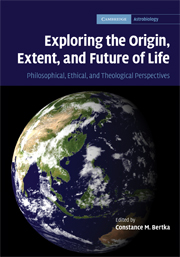 Exploring the Origin, Extent, and Future of Life
Exploring the Origin, Extent, and Future of Life Book contents
- Frontmatter
- Contents
- List of contributors
- Acknowledgements
- 1 Astrobiology in a societal context
- Part I Origin of life
- Part II Extent of life
- Part III Future of life
- 13 Planetary ecosynthesis on Mars: restoration ecology and environmental ethics
- 14 The trouble with intrinsic value: an ethical primer for astrobiology
- 15 God's preferential option for life: a Christian perspective on astrobiology
- 16 Comparing stories about the origin, extent, and future of life: an Asian religious perspective
- Index
- References
13 - Planetary ecosynthesis on Mars: restoration ecology and environmental ethics
from Part III - Future of life
Published online by Cambridge University Press: 29 December 2010
- Frontmatter
- Contents
- List of contributors
- Acknowledgements
- 1 Astrobiology in a societal context
- Part I Origin of life
- Part II Extent of life
- Part III Future of life
- 13 Planetary ecosynthesis on Mars: restoration ecology and environmental ethics
- 14 The trouble with intrinsic value: an ethical primer for astrobiology
- 15 God's preferential option for life: a Christian perspective on astrobiology
- 16 Comparing stories about the origin, extent, and future of life: an Asian religious perspective
- Index
- References
Summary
Introduction
There has been a lively discussion recently about the science and ethics of “terraforming” Mars. The high level of interest is a result of spacecraft discoveries about Mars combined with the realization that humans are effectively warming the Earth and wondering if they can, and should, do the same on Mars. I suggest that terraforming is more appropriately called planetary ecosynthesis, and in this chapter I review the scientific studies of planetary ecosynthesis and the environmental ethics associated with instigating such global change on another planet.
Mars today is a cold, dry, frozen desert world on which not even the most hardy of Earth life could survive. Temperatures average −60°C and the pressure averages 0.6 kPa, over one hundred times less than atmospheric pressure at the surface of the Earth. As a result of the low pressure, and secondarily the low temperature, water is not liquid on the surface of Mars at any location or season. Strong solar ultraviolet radiation reaches the surface of Mars to complete the deadly mix of hostile environmental conditions.
But Mars has not always been this harsh. There is compelling evidence that early in its history Mars had stable liquid water on its surface. Presumably this phase of liquid water was associated with a higher pressure and somewhat warmer atmosphere.
- Type
- Chapter
- Information
- Exploring the Origin, Extent, and Future of LifePhilosophical, Ethical and Theological Perspectives, pp. 245 - 260Publisher: Cambridge University PressPrint publication year: 2009
References
- 22
- Cited by


